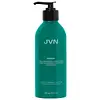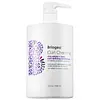What's inside
What's inside
 Key Ingredients
Key Ingredients

 Benefits
Benefits

 Concerns
Concerns

 Ingredients Side-by-side
Ingredients Side-by-side

Water
Skin ConditioningCetearyl Alcohol
EmollientHydrogenated Farnesene
EmollientBrassicamidopropyl Dimethylamine
Skin ConditioningCapryloyl Glycerin/Sebacic Acid Copolymer
Skin ConditioningSqualane
EmollientPhyllostachys Bambusoides Extract
Skin ConditioningGlycerin
HumectantBiotin
AntiseborrhoeicPanthenol
Skin ConditioningDiheptyl Succinate
EmollientCetearyl Olivate
Tocopherol
AntioxidantSorbitan Olivate
EmulsifyingAspartic Acid
MaskingSodium Gluconate
Skin ConditioningEthylhexylglycerin
Skin ConditioningBenzyl Alcohol
PerfumingParfum
MaskingLinalool
PerfumingWater, Cetearyl Alcohol, Hydrogenated Farnesene, Brassicamidopropyl Dimethylamine, Capryloyl Glycerin/Sebacic Acid Copolymer, Squalane, Phyllostachys Bambusoides Extract, Glycerin, Biotin, Panthenol, Diheptyl Succinate, Cetearyl Olivate, Tocopherol, Sorbitan Olivate, Aspartic Acid, Sodium Gluconate, Ethylhexylglycerin, Benzyl Alcohol, Parfum, Linalool
Water
Skin ConditioningCetyl Alcohol
EmollientStearyl Alcohol
EmollientBrassica Alcohol
EmollientGlycerin
HumectantCetyl Esters
EmollientParfum
MaskingBehentrimonium Methosulfate
Caprylic/Capric Triglyceride
MaskingIsopropyl Palmitate
EmollientOryza Sativa Extract
AbsorbentButyrospermum Parkii Butter
Skin ConditioningKeratin Amino Acids
Skin ConditioningHelianthus Annuus Seed Oil
EmollientPrunus Amygdalus Dulcis Oil
Skin ConditioningLactobacillus/Tomato Fruit Ferment Extract
Skin ConditioningAcanthus Mollis Leaf Extract
Skin ConditioningBambusa Vulgaris Extract
Skin ConditioningCitrus Aurantium Dulcis Fruit Extract
MaskingCitrus Aurantium Dulcis Peel Oil
MaskingCitrus Paradisi Peel Oil
MaskingRosa Canina Fruit Oil
EmollientTocopheryl Acetate
AntioxidantPanthenol
Skin ConditioningAloe Barbadensis Leaf Juice
Skin ConditioningSaccharina Longicruris Extract
HumectantAcyl Coenzyme A Desaturase
Skin ConditioningOcimum Basilicum Leaf Extract
Skin ConditioningCetrimonium Chloride
AntimicrobialIsododecane
EmollientGuar Hydroxypropyltrimonium Chloride
Skin ConditioningLeuconostoc/Radish Root Ferment Filtrate
AntimicrobialButylene Glycol
HumectantCitric Acid
BufferingBrassicyl Isoleucinate Esylate
Emulsion StabilisingDehydroacetic Acid
PreservativeBenzyl Alcohol
PerfumingWater, Cetyl Alcohol, Stearyl Alcohol, Brassica Alcohol, Glycerin, Cetyl Esters, Parfum, Behentrimonium Methosulfate, Caprylic/Capric Triglyceride, Isopropyl Palmitate, Oryza Sativa Extract, Butyrospermum Parkii Butter, Keratin Amino Acids, Helianthus Annuus Seed Oil, Prunus Amygdalus Dulcis Oil, Lactobacillus/Tomato Fruit Ferment Extract, Acanthus Mollis Leaf Extract, Bambusa Vulgaris Extract, Citrus Aurantium Dulcis Fruit Extract, Citrus Aurantium Dulcis Peel Oil, Citrus Paradisi Peel Oil, Rosa Canina Fruit Oil, Tocopheryl Acetate, Panthenol, Aloe Barbadensis Leaf Juice, Saccharina Longicruris Extract, Acyl Coenzyme A Desaturase, Ocimum Basilicum Leaf Extract, Cetrimonium Chloride, Isododecane, Guar Hydroxypropyltrimonium Chloride, Leuconostoc/Radish Root Ferment Filtrate, Butylene Glycol, Citric Acid, Brassicyl Isoleucinate Esylate, Dehydroacetic Acid, Benzyl Alcohol
Ingredients Explained
These ingredients are found in both products.
Ingredients higher up in an ingredient list are typically present in a larger amount.
Benzyl Alcohol is most commonly used as a preservative. It also has a subtle, sweet smell. Small amounts of Benzyl Alcohol is not irritating and safe to use in skincare products. Most Benzyl Alcohol is derived from fruits such as apricots.
Benzyl Alcohol has both antibacterial and antioxidant properties. These properties help lengthen the shelf life of products. Benzyl Alcohol is a solvent and helps dissolve other ingredients. It can also improve the texture and spreadability.
Alcohol comes in many different forms. Different types of alcohol will have different effects on skin. This ingredient is an astringent alcohol.
Using high concentrations of these alcohols are drying on the skin. They may strip away your skin's natural oils and even damage your skin barrier. Astringent alcohols may also irritate skin.
Other types of astringent alcohols include:
According to the National Rosacea Society based in the US, you should be mindful of products with these alcohols in the top half of ingredients.
Any type of sanitizing product will have high amounts of alcohol to help kill bacteria and viruses.
Learn more about Benzyl AlcoholGlycerin is already naturally found in your skin. It helps moisturize and protect your skin.
A study from 2016 found glycerin to be more effective as a humectant than AHAs and hyaluronic acid.
As a humectant, it helps the skin stay hydrated by pulling moisture to your skin. The low molecular weight of glycerin allows it to pull moisture into the deeper layers of your skin.
Hydrated skin improves your skin barrier; Your skin barrier helps protect against irritants and bacteria.
Glycerin has also been found to have antimicrobial and antiviral properties. Due to these properties, glycerin is often used in wound and burn treatments.
In cosmetics, glycerin is usually derived from plants such as soybean or palm. However, it can also be sourced from animals, such as tallow or animal fat.
This ingredient is organic, colorless, odorless, and non-toxic.
Glycerin is the name for this ingredient in American English. British English uses Glycerol/Glycerine.
Learn more about GlycerinPanthenol is a common ingredient that helps hydrate and soothe the skin. It is found naturally in our skin and hair.
There are two forms of panthenol: D and L.
D-panthenol is also known as dexpanthenol. Most cosmetics use dexpanthenol or a mixture of D and L-panthenol.
Panthenol is famous due to its ability to go deeper into the skin's layers. Using this ingredient has numerous pros (and no cons):
Like hyaluronic acid, panthenol is a humectant. Humectants are able to bind and hold large amounts of water to keep skin hydrated.
This ingredient works well for wound healing. It works by increasing tissue in the wound and helps close open wounds.
Once oxidized, panthenol converts to pantothenic acid. Panthothenic acid is found in all living cells.
This ingredient is also referred to as pro-vitamin B5.
Learn more about PanthenolParfum is a catch-all term for an ingredient or more that is used to give a scent to products.
Also called "fragrance", this ingredient can be a blend of hundreds of chemicals or plant oils. This means every product with "fragrance" or "parfum" in the ingredients list is a different mixture.
For instance, Habanolide is a proprietary trade name for a specific aroma chemical. When used as a fragrance ingredient in cosmetics, most aroma chemicals fall under the broad labeling category of “FRAGRANCE” or “PARFUM” according to EU and US regulations.
The term 'parfum' or 'fragrance' is not regulated in many countries. In many cases, it is up to the brand to define this term.
For instance, many brands choose to label themselves as "fragrance-free" because they are not using synthetic fragrances. However, their products may still contain ingredients such as essential oils that are considered a fragrance by INCI standards.
One example is Calendula flower extract. Calendula is an essential oil that still imparts a scent or 'fragrance'.
Depending on the blend, the ingredients in the mixture can cause allergies and sensitivities on the skin. Some ingredients that are known EU allergens include linalool and citronellol.
Parfum can also be used to mask or cover an unpleasant scent.
The bottom line is: not all fragrances/parfum/ingredients are created equally. If you are worried about fragrances, we recommend taking a closer look at an ingredient. And of course, we always recommend speaking with a professional.
Learn more about ParfumWater. It's the most common cosmetic ingredient of all. You'll usually see it at the top of ingredient lists, meaning that it makes up the largest part of the product.
So why is it so popular? Water most often acts as a solvent - this means that it helps dissolve other ingredients into the formulation.
You'll also recognize water as that liquid we all need to stay alive. If you see this, drink a glass of water. Stay hydrated!
Learn more about Water